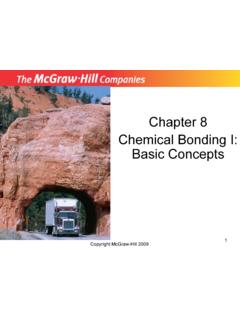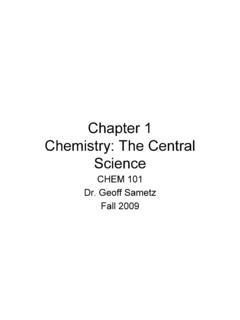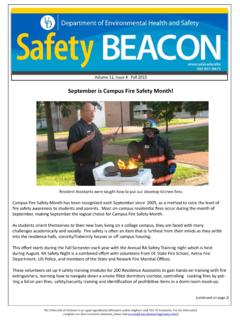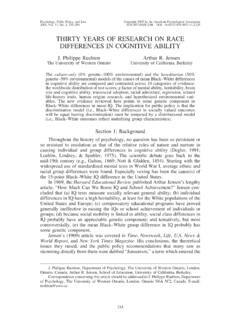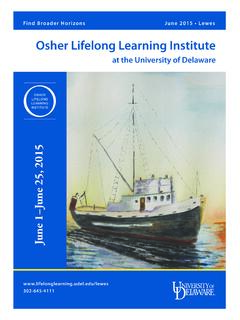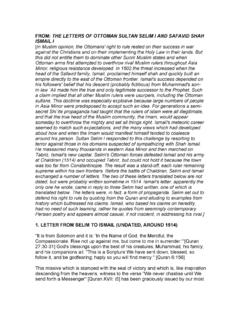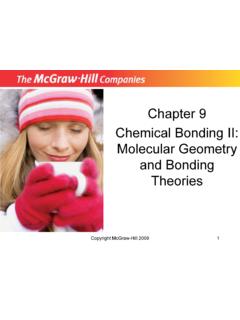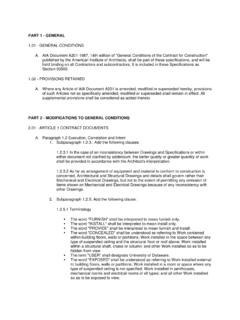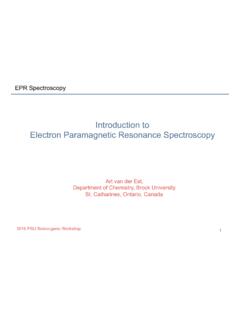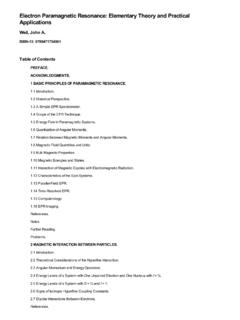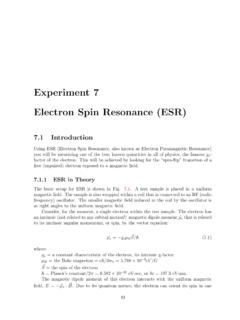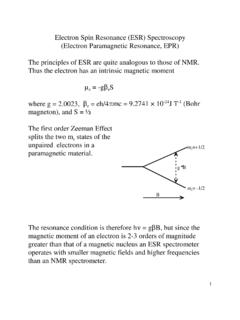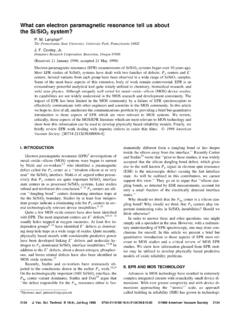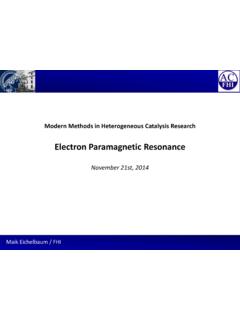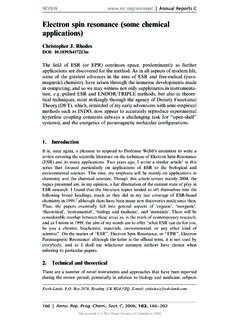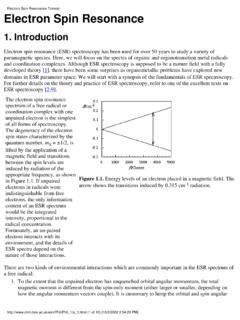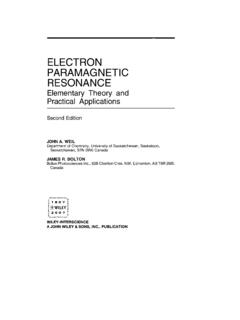Transcription of Paramagnetic spectroscopy of vanadyl complexes and its ...
1 Coordination Chemistry Reviews 228 (2002) 1 spectroscopy of vanadyl complexes and itsapplications to biological systemsThomas S. Smith IIa,b, Russell LoBruttoa,b,*, Vincent L. Pecoraroa,b,*aDepartment of Chemistry,The Uni ersity of Michigan,930 North Uni ersity A enue,Ann Arbor,MI48109-1055,USAbDepartment of Plant Biology,The Center for the Study of Early E ents in Photosynthesis,Arizona State Uni ersity,Tempe,AZ85827-1601,USAR eceived 14 November 2000; received in revised form 18 July 2001; accepted 21 September electron Paramagnetic resonance (EPR).. Introduction to The additivity Model Biological Summary of EPR electron -nuclear double resonance (ENDOR).. Introduction to Model Biological Summary of ENDOR electron spin echo envelope modulation (ESEEM).
2 Introduction to Model Biological Summary of ESEEM .. ability to determine the ligand environment around vanadium(IV), usually as the vanadyl ion (VO2+), has become crucialto the understanding of many biological systems. In addition to those systems in which vanadium naturally occurs, the vanadylion has found favor as a spectroscopic probe in place of spectroscopically silent cations, EPR, ESEEM, and ENDOR spectroscopies are the tools of choice for examining these Paramagnetic systems. A variety of model complex studies allow goodcomparisons to be made to known vanadium environments. The complimentary nature of the strengths and weaknesses of thesetechniques can combine to give an accurate picture of the metal ligation in a number of cases herein. 2002 Published by ElsevierScience :Vanadium; vanadyl ; electron Paramagnetic resonance spectroscopy ; electron spin echo envelope modulation spectroscopy ; electron -nuclear double resonance spectroscopy * Corresponding authors.
3 Tel.:+1-743-763-1519; fax:+ Pecoraro).0010-8545/02/$ - see front matter 2002 Published by Elsevier Science : S0010-8545(01) ,II et Chemistry Re iews228 (2002) 1 1821. IntroductionThe study of the chemistry of vanadium has beendriven by its presence in biological systems. Although,vanadium s existence in ascidians was discovered in1911 by Henze [1], the vast majority of work hasoccurred more recently. Vanadium is now known tooccur naturally in mushrooms as well, and is requiredas an essential cofactor in certain haloperoxidases andnitrogenases [2]. While vanadium is suspected to be anessential trace element for humans [3], as vanandate, itis known to affect phosphate metabolism and variousforms of vanadium have proven to have insulin-mimetic effects [4]. The ability to substitute vanadyl ionfor spectroscopically silent divalent cations, such asMg2+,Ca2+, and Zn2+has led to the increased use ofvanadyl ion (VO2+), as a spectroscopic probe of bio-logical systems using Paramagnetic spectroscopic tech-niques, such as electron Paramagnetic resonance (EPR), electron spin echo envelope modulation (ESEEM), andENDOR.
4 These techniques can provide information asto the number, kinds and in some cases, orientations ofligands around the metal binding intent of this paper is twofold. First, it is acompilation of recent work involving paramagneticspectroscopy of the vanadyl ion in various complexesand biomolecules. Particular attention is paid to ad-vances that have shown what the spectroscopic meth-ods are, and are not capable of examining. Work sincethe Eaton and Eaton review (1990) will be emphasized[5]. Other reviews since 1990 by Makinen and Mustafi[6] and by Chasteen [7] are recommended. Second, it isalso meant to act as a beginning resource to those whomay be interested in starting to use vanadyl ion as aspectroscopic probe in their own system. Since, detaileddescriptions of the theoretical basis of these spectro-scopic techniques are covered in several books andarticles, only a brief introduction is given to familiarizethose, who may not have used these techniques , the reader should obtain a clear sense of thescope of each technique sufficient to pursue work inmore there are examples of non-oxo vanadium(IV) complexes in nature, such as amavadin, the oxophilicityof vanadium(IV) causes the overwhelming majority ofvanadium(IV) compounds to contain the vanadyl ion[8,9].
5 vanadyl ion does oxidize in aerobic aqueoussolution, but at such a slow rate that it can generally bedismissed as negligible. The+4 oxidation level can bestabilized by the addition of other ligands or reducingagents. vanadyl complexes , typically adopt 5-coordi-nate square pyramidal or 6-coordinate distorted octahe-dral, geometries, with the vanadium oxo distance(ca. A ) being shorter than the distance from themetal to the ligandtransto the oxo ( A ).Vanadium(IV) has a d1electron configuration. A dorbital energy level diagram for the vanadyl ion isshown in Fig. 1. The lone d electron is in a -non-bonding orbital, which points away from the ligands inthexyplane. These characteristics will be important inthe discussions to electron Paramagnetic resonance (EPR) to techniqueThe underlying theory behind EPR can be found inany number of textbooks, including ones by Drago [10],Abragam [11], and more recently, Solomon and Lever[12].
6 EPR spectroscopy examines the transitions be-tween electron spin states separated by the presence ofan external magnetic field. These states are separated byan energy dependent on thegvalue of the observedspecies (for the theoretical free electron ,g= )and the magnetic field applied, as shown in Fig. ofgin vanadyl EPR spectra are typically lessthan the free electron value, usually The transi-tion is induced by microwave radiation of frequency ,such thath =g H, wherehis Planck s constant, isthe Bohr magneton, andHis the magnitude of theapplied field. Note that unlike NMR, in the EPRexperiment, the frequency is held constant, and it is thestrength of the magnetic field, which is varied. Theseelectronic states are then split by their interaction withthe spin of the nucleus termed hyperfine the case of vanadium(IV), the nuclear spin of51 VisI=7/2, so the states are split into 2I+1=8 differentenergy states each, separated by the hyperfine couplingconstant,A.
7 Almost all ( 99%) vanadium is51V, sothere are no additional isotopes with nuclear spin tocomplicate the spectrum. Further splitting of states bynearby nuclei, such as14N is referred to as superhy-perfine coupling. For the vanadyl case, due to theFig. 1. Orbital energy levels for the d electrons of the vanadyl ion(VO2+).Fig. 2. The spin state transitions observed in the EPR are shown herefor a system with both electron spinS=1/2 and nuclear spinI=1 ,II et Chemistry Re iews228 (2002) 1 183 Table 1 Contribution toA of different binding moieties (in units of 10 4cm 1)Binding groupA contributionReferenceH2O[15] [20] N [15]Aliphatic imine N Cl [25] (DMF)[16]HC(O)NRR [15] , ArCO2 PO43 [75][15] N [15]40 Par. imidazole[20] N OH [15] [19]acac, 1 O [19] C O RO [15] [15]ArS 32 (ligand charge 2); 37 43 Deprot.
8 Amide[19,25](ligand charge 4)RC(O)NR [15]RS additi ity relationshipEPR spectroscopy is a powerful tool that providesinformation about the elemental composition, nuclear-ity, and electronic structure of a Paramagnetic , investigators determine the apparentgvalueto assess the spin state of a molecule. They can use theextent and magnitude of hyperfine coupling to identifythe nuclei to which the unpaired electron (s) are coupledand to determine the number of nuclei associated withan EPR transition. Through variable temperature andpower studies, one can extract great detail about theelectronic structure of a Paramagnetic ion. The strengthof vanadium(IV) is in its use as a probe of ligandenvironment. Since, the ion has a simpleS=1/2 elec-tronic spin, and because,51V has high natural abun-dance and anI=7/2 nuclear spin, the vanadyl ion canbe used to assess the bonding of ligands to the divalentcomplex ion.
9 An additivity relationship,first proposedby Wuthrich [14] and refined later by Chasteen [15],allows the hyperfine coupling constant, specificallyA ,to be correlated to the number and types of ligandspresent in the equatorial plane. This theory has evolvedfrom merely correlating the isotropic hyperfine couplingconstant,Ao(Ao=[A +2A ]/3), with the number ofnitrogens and oxygens in the equatorial plane to ex-tractingA values and using these hyperfine constantsas more sensitive probe of electronic environment. Eachligand has a specific contribution toA , and the sum ofthe four equatorial ligands contributions will give theA observed. Examination of Table 1 reveals that thecontribution toA correlates approximately inverselywith the electron donor capacity of the ligand, with themost donating ligands contributing the least to thehyperfine coupling.
10 The typicalA varies 10 4and 10 4cm 1, with the generallyaccepted error being ca. 10 4cm 1[15]. Thisintroduces one caveat into the use of the additivityrelationship, there is often more than one combinationof ligands which can, within the error limits, give theexperimentally determinedA . Therefore, one must ei-ther know which types of ligands are possible (as in thecase of small molecules with previously characterizedligands), or use other complementary techniques tonarrow down the the older additivity method usingAoand thenewer method usingA continue to be used in theliterature. Unfortunately, many authors only report oneor the other hyperfine coupling value. Results using thedifferent approaches cannot be compared directly asA is not known. A proper analysis requires thatAobeconverted toA .AsA andA can be obtained froman EPR spectrum with equal ease, it is preferable to listall values of the hyperfine coupling to facilitate com-parison of results.
